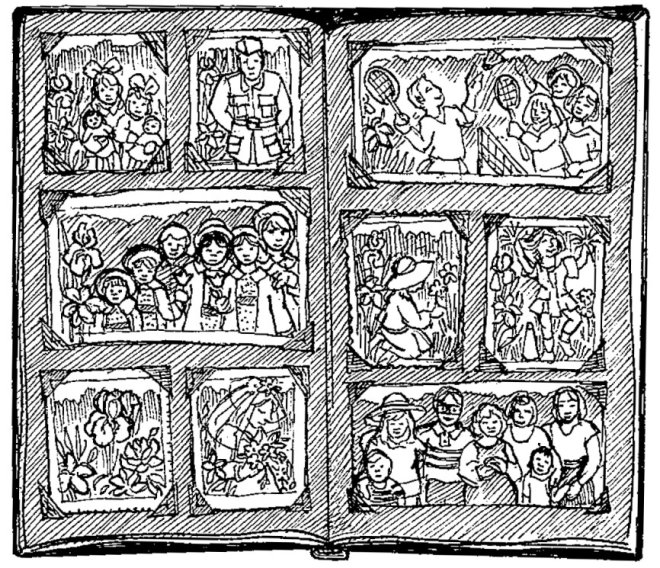
Early in the 20th century, my great-grandfather purchased the Massachusetts house that years later I would grow up in. It was sited on a ledge of pretty pink rock that lay a few inches below the surface. He was a gardener, Great Grandpa, one of the three branches of my family tree that passed the gene on to me. He created, in a place that others would see as wasted land, what became the background for recording all our family events.
When in his 90’s, Great Grandpa became too frail to live at home without additional care. So my family moved in, along with my grand-aunt who had been his caretaker. Aunt Helen was an avid amateur photographer and the chronicler of our family events. I was nine the year we moved in, and from that point on, all our family history was recorded in front of the garden. ‘Get dressed and go stand in the garden’ became the mantra of every christening, confirmation, graduation, and wedding.
Years later, going through old family photos, I found that the garden had been serving this function for generations before me. There were pictures of my mother and her sisters from little girls holding dolls to young adults, some with my great grandparents. There were photos of my grand-uncle in his military uniform and there was Aunt Helen as a young woman. (Someone else did the photography that time.) The tradition was decades old.
We spent many a Winter evening watching Aunt Helen’s slides, often with the tray’s contents upside-down or sideways. “Who’s been playing with my slides?” she’d accuse, but we all knew she was the culprit. Though she’d travelled to many fascinating places, our favorite slides were the ones of us. We’d laugh at the outfits and expressions. We’d watch those outfits move from child to child as the years progressed. The adults would marvel at how we’d grown and rue the passing of time, as I do now when I view the slides.
Each Easter was recorded as well. If you come to my house today, you’ll find the picture of the year my mother and grandaunt made complete Easter outfits for each girl. Apparently, boy’s clothes were too difficult to sew, because my brother was allowed store-bought clothes. There we are in the photo, the six of us lined up by height. The five girls have handmade blue and white floral print dresses with matching blue cummerbunds and coats. They even made coordinating hats decorated with sprays of white silk flowers. The outfits were adorable on the 2-year-old but got progressively dorkier as it moved up the age gradient, skipping briefly over my brother in his red sports coat, and stopping at the gawky 12-year-old—me. It’s a photo that we all hold with great affection and is displayed in every sibling’s home.
This is the garden where I cut my teeth. By the time I began to work in it—not too long after we moved in—it had been ignored for years. Many plants that Great Grandpa established have been lost. But the toughies were still there: the yellow daylily, sedums, hens and chicks, irises, a peony, and a plant we called “Snow on the Mountain.” It was a tough place to learn. The soil was shallow, sandy, rocky, and depleted from years of neglect. I don’t recall finding any earthworms. My main source of plant material was gleaned from walks in the woods and fields and an occasional clipping from a neighbor’s yard. My choices were not always the best, but I learned the basics: transplanting, weeding, planting seeds, how to contort my body to get close to plants, and how to work long hours in the sun.
When I left home, the garden again fell into disrepair, but that never diminished its role as backdrop to our family chronicles. Annuals were popped in to brighten the background in wedding photos. Requests to ‘Say Cheese!’ were met with shouted choruses time after time. After Aunt Helen passed, the quality of the photos declined to common snapshots—but still the garden was the preferred location.
When my mother died, we had to sell the house, the place that had been home to my family for just shy of a century. I returned to the garden to retrieve what I could of my gardening history, but found only sedum, hens and chicks, and a few scraggly irises. Even souvenir-sized pieces of the pink stone had been scavenged over time by a neighbor building a rock garden.
As we prepared to leave the house for the final time, we gathered as many family members as we could for one last photo in front of the garden. Looking at the picture today, I see that we are a motley group dressed in grubby work clothes, representing the last two generations of our family. The children in the Easter photo are the parents here. My middle sister’s belly bulges with yet another addition to the family. If you look closely, the greenery is all weeds. Even the daylily had met its maker.
But I don’t see the weeds. I see all the times we gathered here and smiled. ❖


 Previous
Previous

